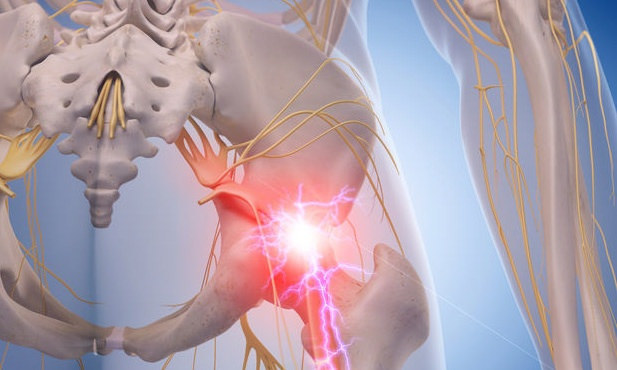Sciatica is a condition characterized by irritation of sciatic nerve (a nerve that comes from either side of the lower spine travelling all the way through the pelvis and buttocks). Any amount of pressure on this nerve or irritation may lead to pain. This pain generally shoots down the back of the thigh or buttock. The pain felt by patients may vary widely.
Usually, sciatica feels like a mild ache. The patient may also feel a very sharp, burning sensation or sometimes extreme discomfort. This condition may cause feelings of tingling, weakness, numbness, and tingling.
Certain activities such as sitting for a long time, prolonged standing, lifting, straining, sneezing, coughing, or twisting may make the symptoms more severe.
The treatment options for sciatic pain may range from hot and cold packs. Doctors may also recommend some exercises, medications and complementary / alternative remedies.
Listed below are some of the best treatment options for sciatica back pain relief :
- Yoga
Iyengar yoga will reduce pain. The gentle forms of yoga will be beneficial. The asanas will strengthen muscles and improve flexibility. They can move and function better.
- Acupuncture
Patients get relief within the first session. Significant improvement can take around 10-12 sessions. Symptoms are known to improve with warming acupuncture. This is a procedure wherein the needles are heated.
- Massage
Trigger-point massage therapy will help sciatica related pain. The affected nerve lies underneath Piriformis (a muscle) located right under the glutes. Tight piriformis muscle pinches the sciatic nerve, which leads to numbness and tingling down into the leg. Pressure is applied to irritated and inflamed areas which provide relief.
- Ice or Heat
The sciatic nerve giving trouble to the body is hidden deep inside the leg and buttock. This means heat or ice on the body surface will not ease inner inflammation. However, you can depend on this treatment by practicing it regularly. Applying an ice pack or a heating pad regularly for 15 minutes will help in the long run.
- Devil’s Claw
This is an herbal medication and a powerful anti-inflammatory. It works very similar to ibuprofen and other similar drugs that inhibit ingredients that drive inflammation. You may look for a brand with standardized extracts of active compound.
- Topical Preparations
Patients may try applying St. John’s wort oil. It is a liniment and help ease conditions related to nerve pain. You simply need to apply this anti-inflammatory oil at least twice or thrice a day on the affected area.
- Pain Relievers and Muscle Relaxants
Some of the non-steroidal anti-inflammatory drugs such as ibuprofen available as over the counter medications or Rx may relief the distress. Aching muscle spasms can also lead to a disk herniation. Doctors may prescribe some pain-reducing tricyclic antidepressants or muscle relaxants.
- Epidural Steroid Injections
When the symptoms do not subside by around 30-40 days, some other therapies can be prescribed by doctors. An x-ray-guided steroid injection is guided into the lower back very near to the location of the sciatic nerve. This treatment is aimed at reducing inflammation within that specific nerve branch. Side effects may be a concern with this type of treatment. Bone density loss is one of the major side effects. Hence, these shots are limited to only three a year.
- Surgery
In case, the symptoms last for over 4-6 weeks, the doctor may consider a surgery for treatment. Surgery for herniated disk results in significant decrease in pain and disability within 3 months. The benefits of sciatica surgery can last for over four years.
Exercise and Physical Therapy
Sciatica patients do not like to move. However, health experts believe that being physically active is very important for patients. Lying in bed all the time or most of the time can make it very difficult for you. An exercise routine will increase the flow of blood to the disk and nerve. This will let you get rid of chemicals causing pain and inflammation. So start with taking around 15- 20-minute walk daily. In case, it hurts you, aerobics or swimming can be the best option. Being in water will not exert much pressure on your back. It is definitely worth seeing a physical therapist. He or she will prescribe some stretching exercises for restoring flexibility of the back. Doctor may also prescribe some moves that will strengthen your core muscles and help add stability to the spine and minimizing the probability of a similar injury.



